江苏新教材牛津英语七年级下
- 格式:ppt
- 大小:1004.50 KB
- 文档页数:23
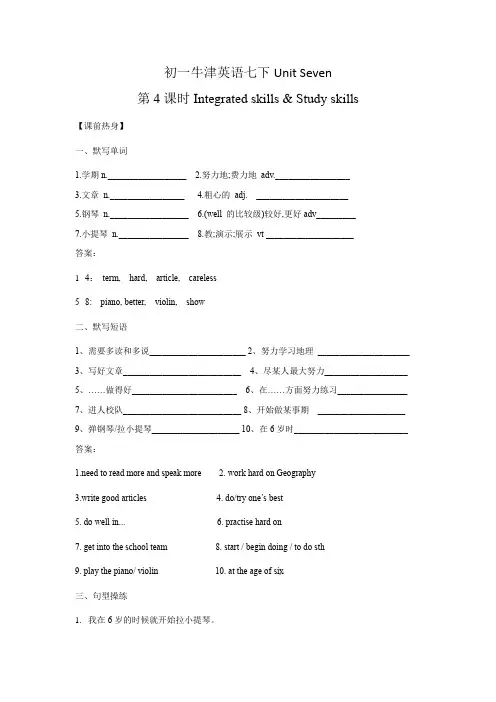
初一牛津英语七下Unit Seven第4课时Integrated skills & Study skills【课前热身】一、默写单词1.学期n.__________________2.努力地;费力地adv._________________3.文章n._________________4.粗心的adj. _____________________5.钢琴n.__________________6.(well 的比较级)较好,更好adv_________7.小提琴n.________________ 8.教;演示;展示vt ____________________答案:1--4:term, hard, article, careless5--8: piano, better, violin, show二、默写短语1、需要多读和多说______________________2、努力学习地理_____________________3、写好文章___________________________4、尽某人最大努力___________________5、……做得好________________________6、在……方面努力练习________________7、进人校队___________________________8、开始做某事期____________________9、弹钢琴/拉小提琴____________________ 10、在6岁时__________________________答案:1.need to read more and speak more2. work hard on Geography3.write good articles4. do/try one’s best5. do well in...6. practise hard on7. get into the school team 8. start / begin doing / to do sth9. play the piano/ violin 10. at the age of six三、句型操练1.我在6岁的时候就开始拉小提琴。

《英语》(七年级下册)Unit 1 Dream homesReading (I)I. Teaching aims and learning objectivesBy the end of the lesson, students should be able to:1. learn about different parts of a home;2. learn about three kinds of homes in different countries;3. understand what the home really means.II. Teaching contents1. New words and phrases: mile, garden, flat, centre, living room, share, bedroom, own, bathroom,balcony, beach, sea, dining room, share sth with sb2. New structures: I live in a town 15 miles from London.I live in a flat in the centre of Moscow.I share a bedroom with my sister.I have my own bedroom and bathroom.I love to sit there and look out at the beach and the sea.III. Focus of the lesson and predicted area of difficulty1. To talk about different parts of a home.2. To remember the details of the three homes in the article.3. To promote the favourite home among the three.IV. Teaching proceduresStep 1 Lead-inT: Hello, boys and girls. Last class we talked about different countries and we’ve got to know that Eddie’s favourite home is the one next to the biggest restaurant. Today, let’s go on to talk about different homes around the world.【设计意图:由上一节课的话题different countries直接引入到本节课的话题different homes。
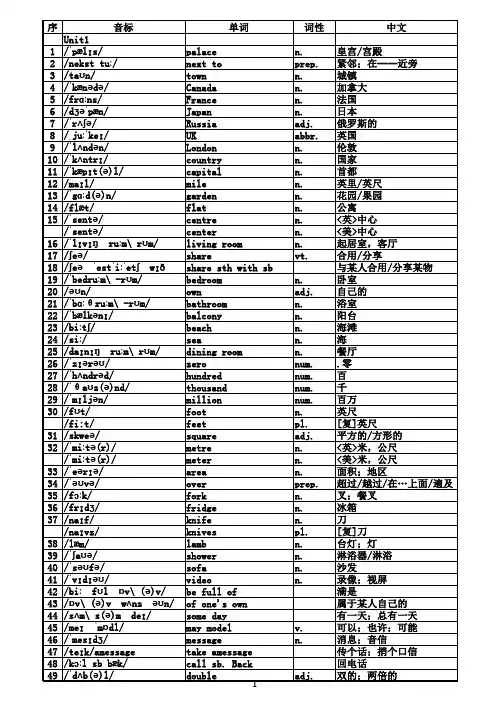
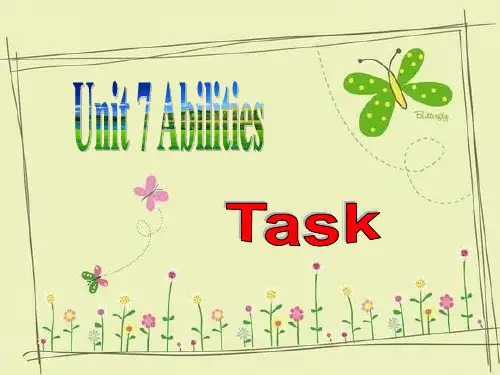
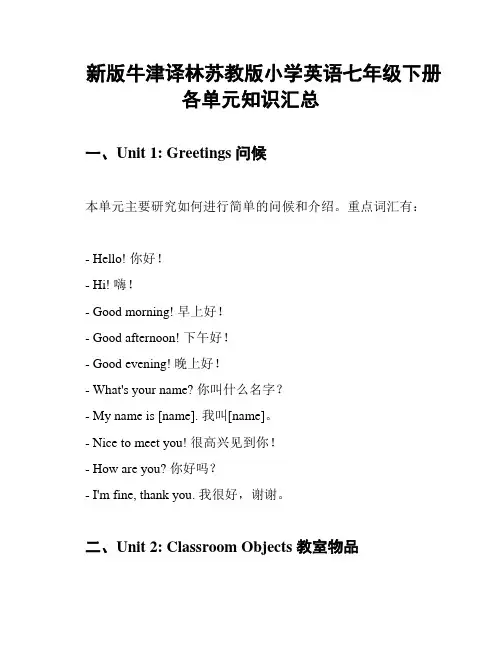
新版牛津译林苏教版小学英语七年级下册各单元知识汇总一、Unit 1: Greetings 问候本单元主要研究如何进行简单的问候和介绍。
重点词汇有:- Hello! 你好!- Hi! 嗨!- Good morning! 早上好!- Good afternoon! 下午好!- Good evening! 晚上好!- What's your name? 你叫什么名字?- My name is [name]. 我叫[name]。
- Nice to meet you! 很高兴见到你!- How are you? 你好吗?- I'm fine, thank you. 我很好,谢谢。
二、Unit 2: Classroom Objects 教室物品本单元主要研究教室里常见的物品。
重点词汇有:- desk 课桌- chair 椅子- book 书- pen 笔- pencil 铅笔- ruler 尺子- eraser 橡皮擦- bag 书包- notebook 笔记本- blackboard 黑板三、Unit 3: Numbers 数字本单元主要研究基本的数字表达。
重点词汇有:- one 一- two 二- three 三- four 四- five 五- six 六- seven 七- eight 八- nine 九- ten 十四、Unit 4: Family 家庭本单元主要研究家庭成员的称呼。
重点词汇有:- father 父亲- mother 母亲- brother 兄弟- sister 姐妹- grandfather 爷爷- grandmother 奶奶- aunt 阿姨- uncle 叔叔- cousin 堂兄弟/堂姐妹五、Unit 5: Colors 颜色本单元主要研究颜色的表达。
重点词汇有:- red 红色- blue 蓝色- yellow 黄色- green 绿色- orange 橙色- purple 紫色- black 黑色- white 白色- pink 粉色- brown 棕色六、Unit 6: Weather 天气本单元主要研究天气的描述。

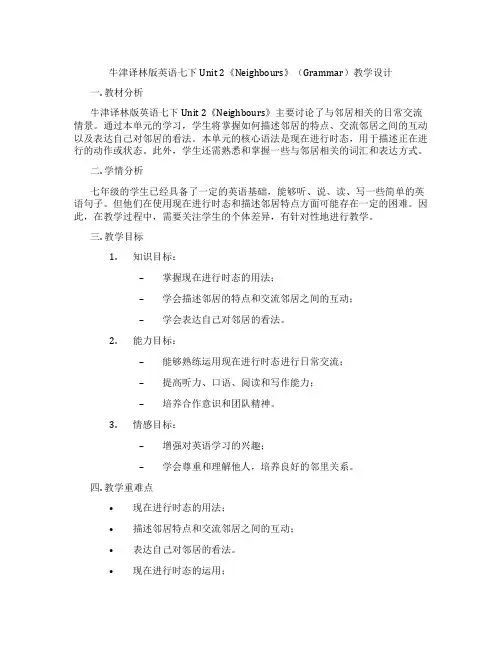
牛津译林版英语七下Unit 2《Neighbours》(Grammar)教学设计一. 教材分析牛津译林版英语七下Unit 2《Neighbours》主要讨论了与邻居相关的日常交流情景。
通过本单元的学习,学生将掌握如何描述邻居的特点、交流邻居之间的互动以及表达自己对邻居的看法。
本单元的核心语法是现在进行时态,用于描述正在进行的动作或状态。
此外,学生还需熟悉和掌握一些与邻居相关的词汇和表达方式。
二. 学情分析七年级的学生已经具备了一定的英语基础,能够听、说、读、写一些简单的英语句子。
但他们在使用现在进行时态和描述邻居特点方面可能存在一定的困难。
因此,在教学过程中,需要关注学生的个体差异,有针对性地进行教学。
三. 教学目标1.知识目标:–掌握现在进行时态的用法;–学会描述邻居的特点和交流邻居之间的互动;–学会表达自己对邻居的看法。
2.能力目标:–能够熟练运用现在进行时态进行日常交流;–提高听力、口语、阅读和写作能力;–培养合作意识和团队精神。
3.情感目标:–增强对英语学习的兴趣;–学会尊重和理解他人,培养良好的邻里关系。
四. 教学重难点•现在进行时态的用法;•描述邻居特点和交流邻居之间的互动;•表达自己对邻居的看法。
•现在进行时态的运用;•准确描述邻居特点和交流邻居之间的互动。
五. 教学方法1.情境教学法:通过设定真实的邻里场景,让学生在实际语境中学习和运用英语;2.交际教学法:鼓励学生进行角色扮演,模拟邻里之间的交流,提高口语表达能力;3.任务型教学法:通过完成小组任务,培养学生合作意识和团队精神;4.反馈与激励:及时给予学生反馈,鼓励学生积极参与课堂活动。
六. 教学准备1.教材:牛津译林版英语七下Unit 2《Neighbours》;2.多媒体课件:图片、视频、音频等教学资源;3.学习任务单:用于引导学生进行小组讨论和任务完成;4.板书用品:黑板、粉笔等。
七. 教学过程1.导入(5分钟)利用图片或视频展示邻居之间的日常生活场景,引导学生谈论自己的邻居。
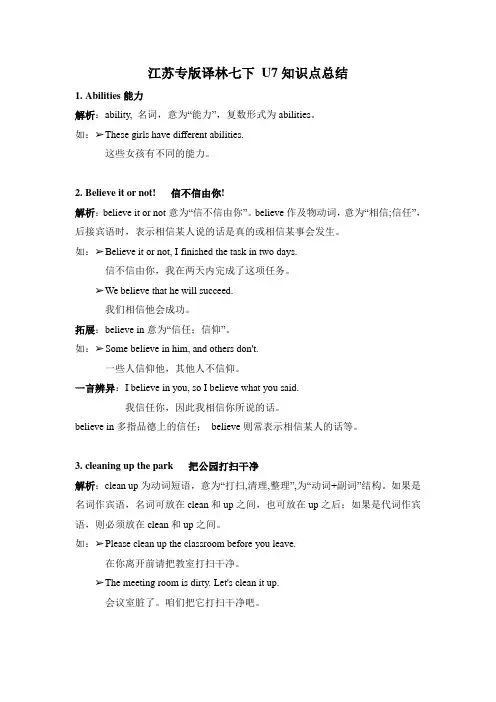
江苏专版译林七下U7知识点总结1.Abilities能力解析:ability, 名词,意为“能力”,复数形式为abilities。
如:➢ These girls have different abilities.这些女孩有不同的能力。
2.Believe it or not! 信不信由你!解析:believe it or not意为“信不信由你”。
believe作及物动词,意为“相信;信任”,后接宾语时,表示相信某人说的话是真的或相信某事会发生。
如:➢ Believe it or not, I finished the task in two days.信不信由你,我在两天内完成了这项任务。
➢ We believe that he will succeed.我们相信他会成功。
拓展:believe in意为“信任;信仰”。
如:➢ Some believe in him, and others don't.一些人信仰他,其他人不信仰。
一言辨异:I believe in you, so I believe what you said.我信任你,因此我相信你所说的话。
believe in多指品德上的信任;believe则常表示相信某人的话等。
3.cleaning up the park 把公园打扫干净解析:clean up为动词短语,意为“打扫,清理,整理”,为“动词+副词”结构。
如果是名词作宾语,名词可放在clean和up之间,也可放在up之后;如果是代词作宾语,则必须放在clean和up之间。
如:➢ Please clean up the classroom before you leave.在你离开前请把教室打扫干净。
➢ The meeting room is dirty. Let's clean it up.会议室脏了。
咱们把它打扫干净吧。
4.giving a seat to someone on the bus 在公共汽车上给某人让座解析:seat是可数名词,意为“座位”。
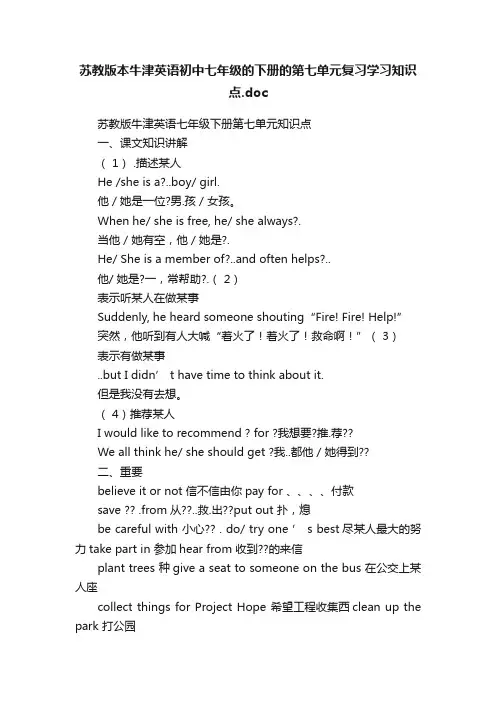
苏教版本牛津英语初中七年级的下册的第七单元复习学习知识点.doc苏教版牛津英语七年级下册第七单元知识点一、课文知识讲解( 1) .描述某人He /she is a?..boy/ girl.他 / 她是一位?男.孩 / 女孩。
When he/ she is free, he/ she always?.当他 / 她有空,他 / 她是?.He/ She is a member of?..and often helps?..他/ 她是?一,常帮助?.( 2)表示听某人在做某事Suddenly, he heard someone shouting“Fire! Fire! Help!”突然,他听到有人大喊“着火了!着火了!救命啊!”( 3)表示有做某事..but I didn’ t have time to think about it.但是我没有去想。
( 4)推荐某人I would like to recommend ? for ?我想要?推.荐??We all think he/ she should get ?我..都他 / 她得到??二、重要believe it or not 信不信由你pay for 、、、、付款save ?? .from从??..救.出??put out 扑,熄be careful with 小心?? . do/ try one ’ s best尽某人最大的努力take part in 参加hear from 收到??的来信plant trees 种give a seat to someone on the bus 在公交上某人座collect things for Project Hope 希望工程收集西clean up the park 打公园visit an old people ’ s 拜home养老院三、法知点解情态动词can、could、may 没有人称和数的变化,虽有词义但不完整,不能单独作谓语,必须和动词原形连用,才能表达完整的意思。

